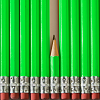Or search by topic
Number and algebra
Geometry and measure
Probability and statistics
Working mathematically
Advanced mathematics
For younger learners
Tin Tight



- Problem
- Getting Started
- Student Solutions
- Teachers' Resources
How many cubic centimetres make a litre?
If the tin (cylinder) had a diameter of $10 \; \text{cm}$ what would the height be?
What surface area would this tin have? Don't forget the top and the bottom.
Would a diameter of $20 \; \text{cm}$ have a greater or lesser surface area?
Can you write out a procedure to follow for any diameter you have to try?
Try to follow your procedure and use trial and improvement to get increasingly close to the diameter which gives the lowest value for the complete surface area.
What was the height for that radius value?
What was the proportion between the height and the diameter?
A spreadsheet might be useful once you are sure of your method.
You may also like

F'arc'tion
At the corner of the cube circular arcs are drawn and the area enclosed shaded. What fraction of the surface area of the cube is shaded? Try working out the answer without recourse to pencil and paper.

